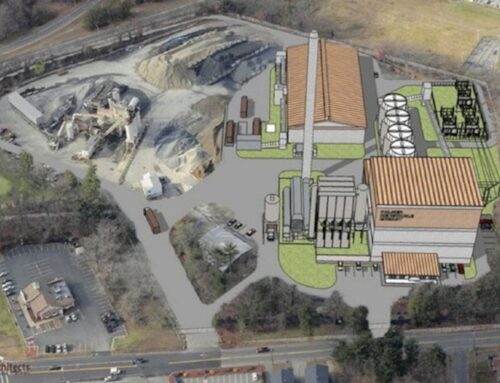Protesters to state officials: Change clean energy siting rules in new Climate Action Plan
May 7, 2025
HOLYOKE — Unperturbed by the rain that pelted their colorful signs, dozens of impassioned community members hailing from cities and towns across the region gathered in song and frustration to protest state “green energy” infrastructure siting practices they think will be more harmful to the environment than helpful.
They gathered Monday outside of the visitor center at Heritage State Park, just before state officials held a public meeting to take input about new siting rules outlined in the state’s new Climate Action Plan.
Protesters took turns announcing over a megaphone why they were braving the weather to make their voices heard. In these short speeches, a common theme emerged — they want a cleaner, greener future, but they don’t think sacrificing forested land to renewable energy projects will make that future come any sooner.
“I’m here because I’m a stakeholder. I breathe air. How many people here breathe air?” Wendell resident Sally Stuffin asked her fellow protesters, garnering a round of whoops and cheers. “You’re a stakeholder … Every blade of grass is a stakeholder.”
As the protesters sang, cheered and called for change, even more area residents filtered into the visitor center, shaking off umbrellas and ponchos as they waited for members of the Massachusetts Energy Facilities Siting Board (EFSB) to arrive.
Whether they attended the rainy rally beforehand or opted immediately for the dry interior of the building, most of the meeting’s attendees were drawn to the park that evening because they wanted to provide input on the implementation of the state’s Climate Action Plan released last year.
Some wanted forested land left unscathed in the path of green energy development, while others wanted more local power regarding green energy project siting. But those who spoke tended to agree that so far, the state’s approach to reaching “green energy” goals has left them wanting, especially when reaching those goals means large energy projects popping up in their communities despite concerns within municipalities.
“This is a government takeover of our democracy,” protester Bill Stubblefield said into the megaphone before the meeting. “We need an energy policy for the future, for the people and for all living things.”
Article continues after…
Lara Wahl, a Shutesbury resident who protested and spoke at the meeting, told the Gazette that what mobilized her and many others to come to the meeting was the way big energy projects are being pushed onto municipalities. And when those municipalities resist, she said, the energy companies sometimes pursue legal action.
“The whole thing is that so many towns … are in current lawsuits with solar companies, renewable energy companies — and these are really progressive towns,” said Wahl. “Renewable energy should have been this really exciting thing, but it’s been so poorly mismanaged.”
This meeting was the last of four Climate Act Stakeholder Sessions, designed to inform the public on the implementation of new siting and permitting changes required by law, and to obtain community input on what might be missing from these changes. The Monday meeting tackled the topics of analyzing the cumulative impacts of energy projects, and laying out site suitability criteria for the project siting process.
The input gathered at these meetings and through written comments submitted by May 19 will inform future changes to the regulations, which will be presented at public hearings this fall. The EFSB aims to have new regulations solidified by March.
The 2024 Climate Act was signed into law by Gov. Maura Healey in November 2024, and changed the way energy infrastructure is sited and permitted in the state.
Michael Judge, undersecretary of energy at the Executive Office of Energy and Environmental Affairs (EEA), explained that in order to meet state energy goals, a “very large amount” of energy capacity building must be done in the next 25 years. Judge said that existing permitting processes for energy projects had hindered growth by being “lengthy” and “unpredictable,” necessitating changes.
Some community members who spoke at the meeting argued that the new regulations put an emphasis on smoothing out the permitting process for energy companies, leaving local municipalities with little control over what gets built in their backyards.
In response, Rick Collins, director of clean energy siting and permitting at the state Department of Energy Resources, said that the 12-month siting timeline for energy projects is intended to be a way of “respecting both sides.” This timeframe, he said, provides a balance between projects getting rapidly pushed through versus being drawn out and leading to fatigue among locals who have to attend many meetings to address a given project.
María Belén Power, undersecretary of environmental justice and equity at EEA, explained that a primary goal of these stakeholder sessions is to foster “meaningful engagement and equitable distribution … of the benefits and the burdens” of energy infrastructure projects. This is why this particular session focused on setting forth the aspects of a site that would make it less suitable for development, like the potential public health risks it may pose, as well as creating a guide for cumulative impact analysis.
Cumulative impact analysis for energy projects will involve developing a baseline state for a proposed site based on four characteristics: the built environment, climate change, the natural environment and population characteristics. The goal of finding the baseline in these areas is for the EFSB to determine how a project will impact an area or community.
But unease about the new regulations continued to circulate throughout the meeting despite the assurances of gathered board members.
Chris Queen, a Wendell resident and member of the activist group No Assault and Batteries called for the ability of municipalities to protect their citizens and environments in the face of energy development. Namely, he said that “solar facilities must be sited on previously developed land,” rather than on forested land where trees would have to be removed to make way.
Dan Ogden, a community member who attended the meeting online, said he found the language surrounding siting effects on public and environmental health to be “vague, inconclusive and subject to manipulation.”
“Developers are given entirely too much leniency,” Ogden said.
Assistant Secretary of Environmental Justice at EEA Crystal Johnson, EFSB Director Andrew Greene and Belén Power declined to provide comment to the Gazette at the meeting.
The EFSB is accepting written comments on proposed regulations, and board members said that commentary sent before May 19 will receive the most consideration. Written comments can be sent to sitingboard.filing@mass.gov.
Alexa Lewis can be reached at alewis@gazettenet.com.
Search
RECENT PRESS RELEASES
Related Post







